Last updated: February 20, 2023
Article
50 Nifty Finds #13: The Artistry of Adult Coloring
Coloring isn't just for kids, you know. In fact, long before the adult coloring trend took off in the 2010s, the National Park Service (NPS) paid people to color.
Sounds relaxing, right? Maybe not, if this photo from the NPS History Collection is anything to go by. The "NO TALKING" sign above the door at the NPS Western Museum Laboratory (WML) lantern slide coloring department suggests it wasn't a jolly workplace. On the other hand, the work required concentration as well as a steady hand, good eyesight (even with the magnifying lenses and light tables seen in the photo), and artistic talent— so maybe not being distracted by coworkers was necessary.

17th-Century Magic
Lantern slides date to the 1600s when the first slide projector, called a “magic lantern," was invented. The earliest slides were hand-painted images on glass. By 1850 slides began to be made from negatives, creating positive transparent photographs on glass to project onto a wall or screen for viewing. The black and white images were then hand colored for added interest.
Long before social media (or even before your family's slide collections of the 1950s and 1960s), lantern slides were a popular way to show far-off places, historical characters, or special events at meetings, clubs, and other social gatherings. Businesses like the Keystone View Company and photographers such as Henry G. Peabody created and sold educational lantern slide programs with accompanying guides to schools, libraries, and other groups. National parks were popular subjects for these programs. Do-it-yourself kits were also sold, and amateur photographers, museums, and universities often created their own lantern slides for entertainment or education.

The NPS adopted the technology to illustrate park lectures and to promote national parks. In the 1920s the NPS began creating lantern-slide collections of its own, becoming less reliant on materials sold commercially. Some parks placed a high value on having lantern-slide collections for their programs. Dr. Margaret Fuller Boos was hired as a temporary ranger-naturalist at Rocky Mountain National Park in 1928, even though Superintendent Roger W. Toll stated that he “should prefer a man for the work.” Although Fuller Boos was the first woman with a PhD hired by the NPS, it wasn’t her doctorate in geology that convinced Toll to hire her. Her valuable lantern-slide collection—and his desire to have her make some for the park—was her overriding qualification in his eyes.
In January 1934 the NPS began its lantern slide operations in earnest as Works Progress Administration (WPA) funding allowed WML to set up two darkrooms and hire unemployed photographers and artists to complete the work. Chief Naturalist Ansel F. Hall noted at the time that 200 slides could be made per day by two operators working in the darkrooms. Hand coloring took longer, but 287 slides were colored in the first month. Using an assembly-line process, they vastly increased the number of lantern-slides available to the NPS.
WML provided them free to parks and the Washington office. WML's April 1938 product catalog noted, "Most of the parks have already advantage of our lantern slide department and have obtained quantities of colored slides." Although parks could provide WML with the glass slides to color, WML preferred to make them from negatives. Often park staff supplied the color notes for the artists. If they didn't, the artists had to guess which colors were best for a given scene. WML also made wooden carry boxes and filing cabinets for lantern slides. By October 1938 WML began making Kodaslide carrying cases. In its 1939 products catalog, WML noted, "The new Kodaslides are replacing the colored lantern slides in some parks. Most of the parks using this new film are sending the processed rolls to us, along with a sufficient supply of cover glass, tape, etc., with a request that they be mounted here." WML also quickly adapted by designing and making Kodaslide storage cabinets for parks.
The handwriting was on the wall for hand-colored slides. World War II ended New Deal programs like WPA and largely put a stop to the NPS lantern slide program. After the war, glass-mounted Kodaslides and other color films replaced the hand-colored artistry of lantern-slides in NPS programs.
Coloring Made Easy
Try your hand at "coloring" some of the lantern slides in the NPS History Collection. Use the slider on each image below to see the image before and after it was hand colored. Notice the different artists' skill levels, their color choices, use of shading, and level of detail. The best examples resemble high-quality oil paintings. It's easy to see how such images would have added to a ranger's program or encouraged people to visit national parks.
(Note that the color was digitally removed from each lantern slide to create the black and white version. In addition, some images were cropped and resized to be compatible with the image comparison viewer).
Mount Rainier National Park


Left image
Left to right: Mrs. Tomlinson, the two Tomlinson boys, Grace Albright, Marian Albright, Bob Albright, and Superintendent Tomlinson at Mount Rainier National Park, ca. 1930.
Credit: NPS History Collection (HFCA 1645)
Right image
Hand-colored version of the image on the left.
Credit: NPS History Collection (HFCA 1645)
General Grant National Park (now part of Sequoia & Kings Canyon National Park)
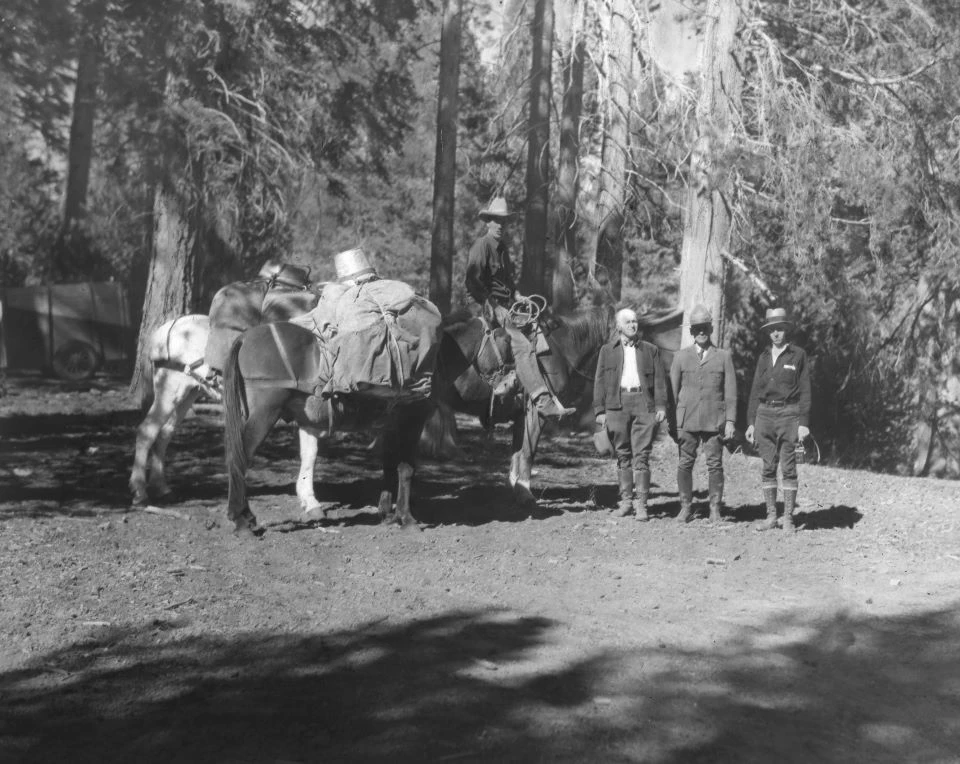

Left image
Left to right: Rangers Ike Livermore, Frank Kittredge, Guy Tobin, and William Schultz at General Grant National Park, ca. 1930s
Credit: NPS History Collection (HFCA 1607)
Right image
Hand-colored version of the image on the left.
Credit: NPS History Collection (HFCA 1607)
Mesa Verde National Park
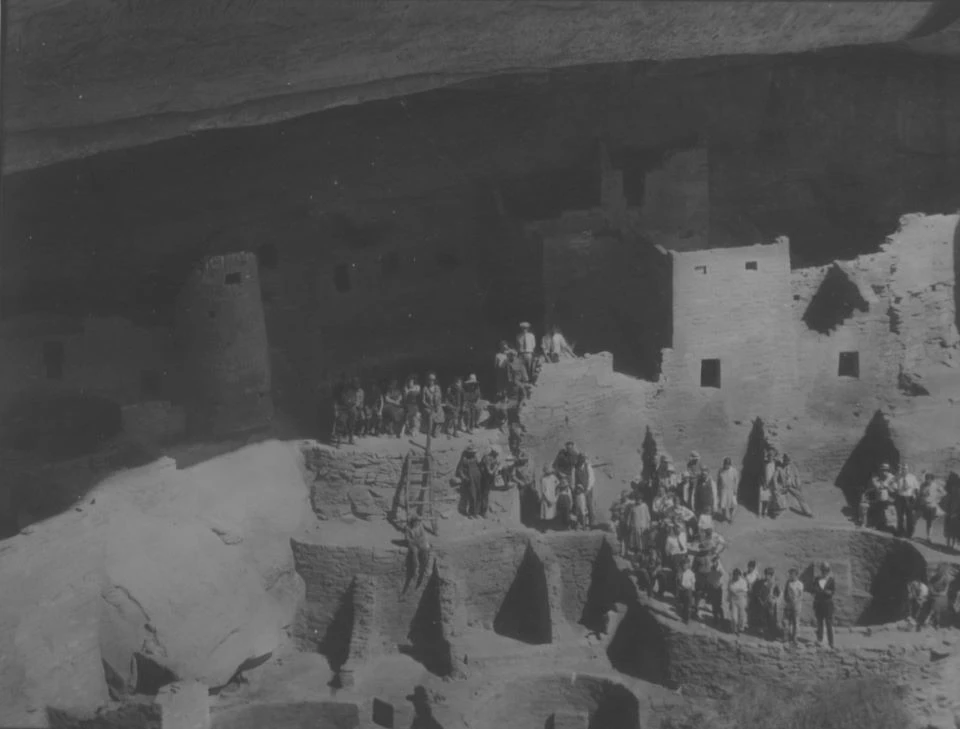

Left image
Visitors at Cliff Palace, Mesa Verde National Park.
Credit: NPS History Collection (HFCA 1645)
Right image
Hand-colored version of the image on the left.
Credit: NPS History Collection (HFCA 1645)
Yellowstone National Park


Left image
Auto tour past Sylvan Lake, Yellowstone National Park, ca 1920s.
Credit: NPS History Collection photo by F.J. Haynes (HPC-001520)
Right image
Hand-colored version of the image on the left.
Credit: NPS History Collection photo by F.J. Haynes (HPC-001520)
Sequoia National Park


Left image
Stagecoach in Sequoia National Park, ca. 1890s.
Credit: NPS History Collection (HPC-001730)
Right image
Hand-colored version of the image on the left.
Credit: NPS History Collection (HPC-001730)
Yellowstone National Park


Left image
Sapphire Pool in Biscuit Basin at Yellowstone National Park, ca 1920s..
Credit: NPS History Collection photo by Henry G. Peabody (HFCA 1979)
Right image
Hand-colored version of the image on the left.
Credit: NPS History Collection photo by Henry G. Peabody (HFCA 1979)
Yosemite National Park

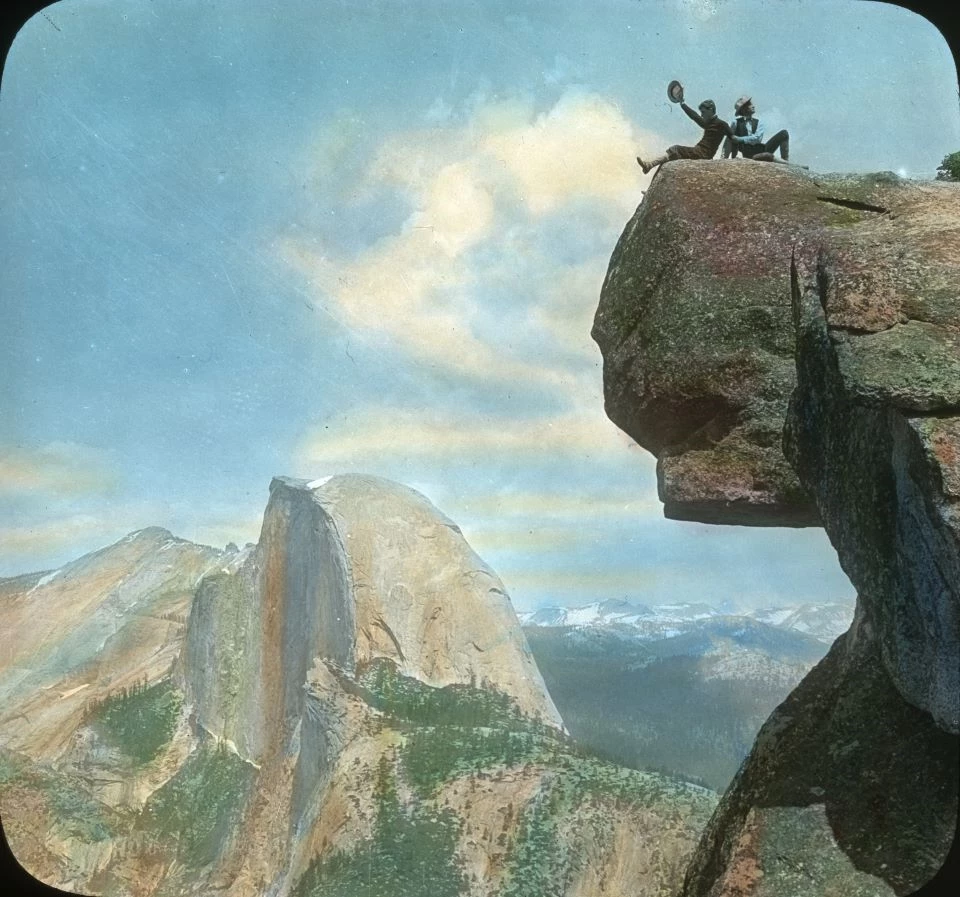
Left image
Enjoying the view of Half Dome from Glacier Point, Yosemite National Park, 1915.
Credit: NPS History Collection (HPC-001815)
Right image
Hand-colored version of the image on the left.
Credit: NPS History Collection (HPC-001815)
Zion National Park


Left image
Zion Lodge, ca. 1930s.
Credit: NPS History Collection photo by Wilkes (HPC-001817)
Right image
Hand-colored version of the image on the left.
Credit: NPS History Collection photo by Wilkes (HPC-001817)
Crater Lake National Park
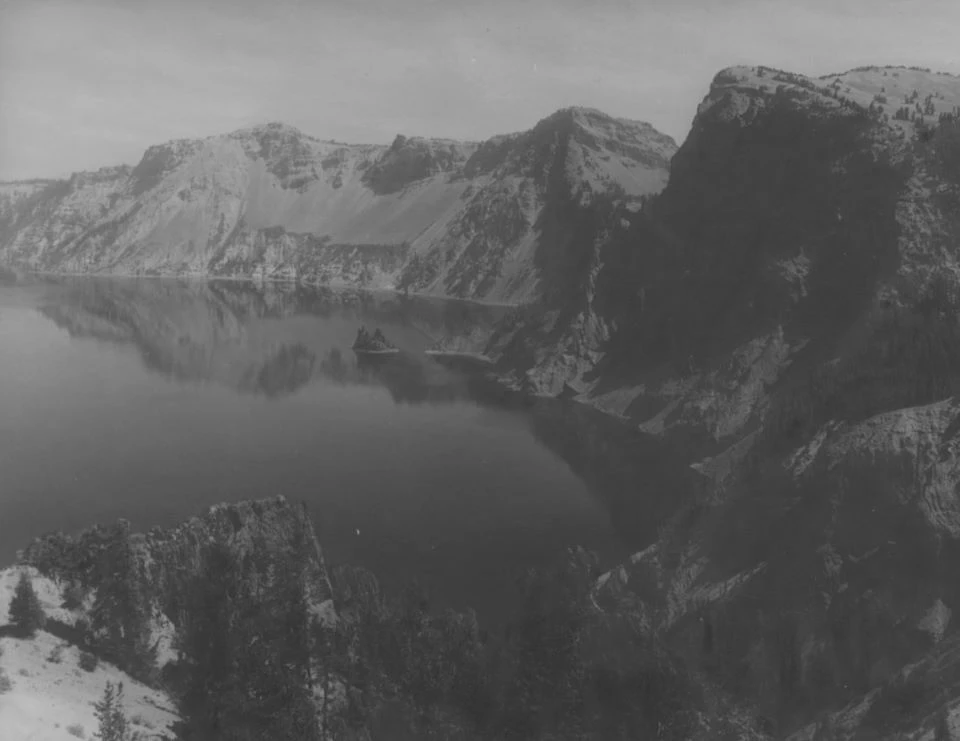

Left image
View of Crater Lake, ca. 1930s.
Credit: NPS History Collection (HFCA 1645)
Right image
Hand-colored version of the image on the left.
Credit: NPS History Collection (HFCA 1645)
Glacier National Park


Left image
Hikers on snow field returning from Grinnell Glacier, Glacier National Park, ca. 1930s.
Credit: NPS History Collection (HPC-001581)
Right image
Hand-colored version of the image on the left.
Credit: NPS History Collection (HPC-001581)
Petrified Forest National Monument (now a national park)
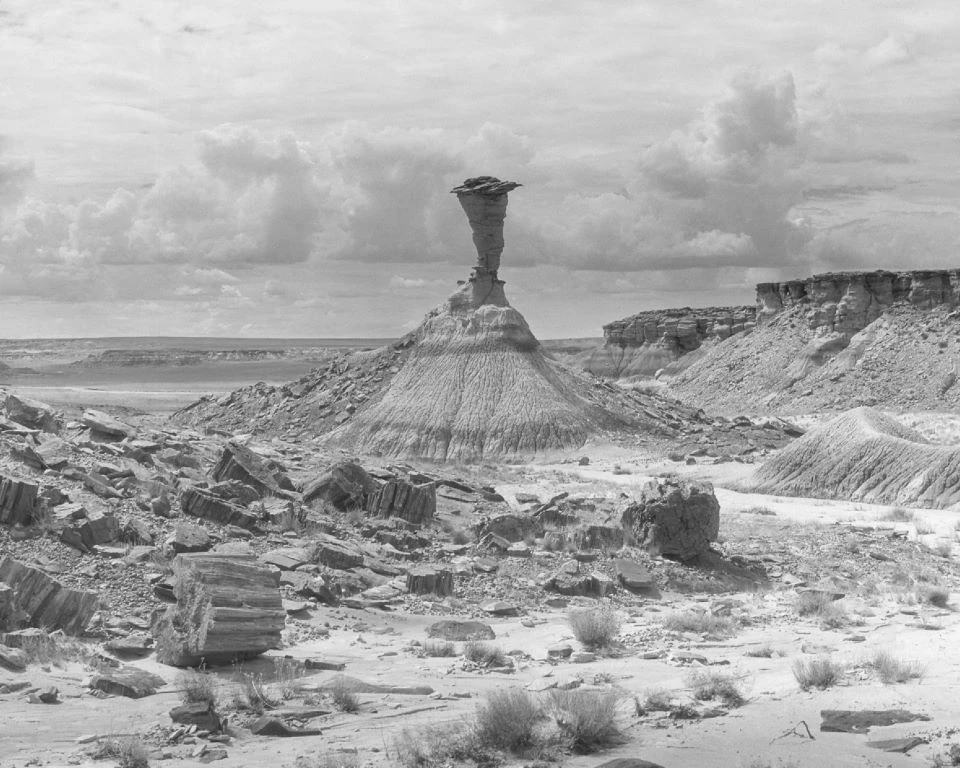

Left image
Eagle Rock, an eroded column in the First Forest, Petrified Forest National Monument, ca. 1930s.
Credit: NPS History Collection photo by Henry G. Peabody (HFCA 1979)
Right image
Hand-colored version of the image on the left.
Credit: NPS History Collection photo by Henry G. Peabody (HFCA 1979)
Grand Teton National Park
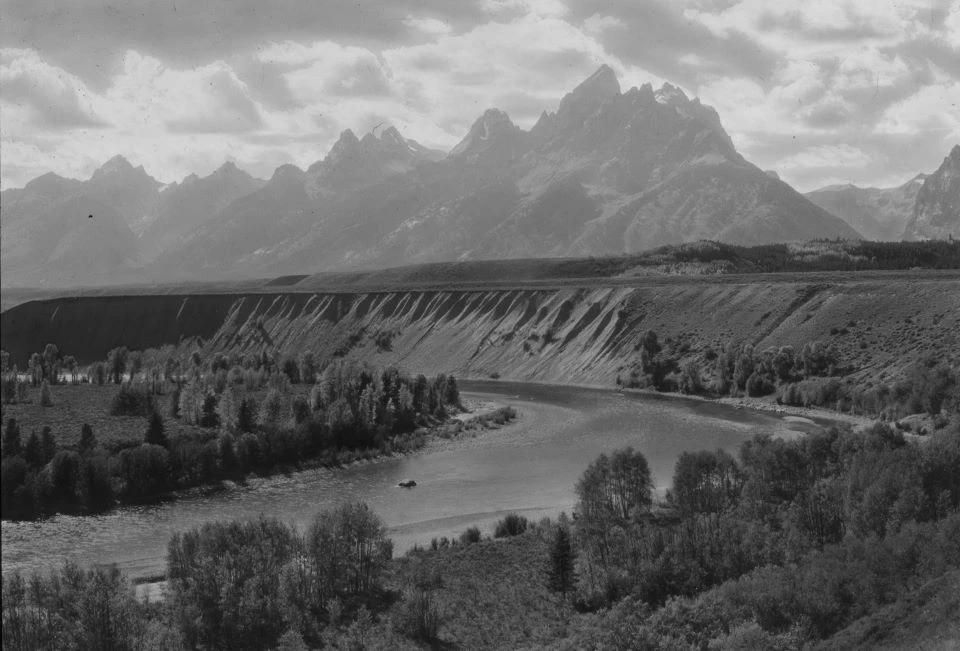

Left image
Teton Range from Dead Man's Bar.
Credit: NPS History Collection (HPC-001592)
Right image
Hand-colored version of the image to the left.
Credit: NPS History Collection (HPC-001592)
Sources:
“Assembled Historic Records of the National Park Service.” NPS History Collection (HFCA 1645).
Lewis, Ralph H. (1993). Museum Curatorship in the National Park Service, 1904-1982. National Park Service Curatorial Services Division, Washington, DC.
National Park Service. (1934, February-March). “Numerous Photographs, Films, and Slides Being Made.” Park Service Bulletin, Vol. 4, No. 2. Washington, DC. (NPS History Collection, HFCA 1645).
Tags
- crater lake national park
- glacier national park
- grand teton national park
- mesa verde national park
- mount rainier national park
- petrified forest national park
- sequoia & kings canyon national parks
- yellowstone national park
- yosemite national park
- zion national park
- nps history collection
- nps history
- hfc
- photography
- lantern slide
- western museum laboratories
- art
